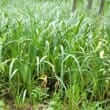Background
- Acorus calamus L. (family Araceae/Acoraceae) has long, narrow leaves and an aromatic rootstock. It is similar to the iris in appearance and can be found in moist habitats such as the banks of ponds or streams and swamps in North America, Europe, and Asia.
- Traditional medicine includes use of the rhizome and the herb's main traditional uses include therapy for colic, dyspepsia (upset stomach), and flatulence (gas). In Ayurveda there is major use of calamus for diseases of the kidney and liver, eczema, rheumatism, and enhancement of memory. Currently, traditional uses lack substantiation in the available medical literature. Vomiting was the primary toxicity reported following use of the root for assumed production of euphoria.
References
Natural Standard developed the above evidence-based information based on a thorough systematic review of the available scientific articles. For comprehensive information about alternative and complementary therapies on the professional level, go to . Selected references are listed below.
- Ahmad I, Aqil F. In vitro efficacy of bioactive extracts of 15 medicinal plants against ESbetaL-producing multidrug-resistant enteric bacteria. Microbiol Res 7-26-2006.
View Abstract - Aqil F, Ahmad I, Owais M. Evaluation of anti-methicillin-resistant Staphylococcus aureus (MRSA) activity and synergy of some bioactive plant extracts. Biotechnol J 2006;1(10):1093-1102.
View Abstract - Bains JS, Dhuna V, Singh J, et al. Novel lectins from rhizomes of two Acorus species with mitogenic activity and inhibitory potential towards murine cancer cell lines. Int Immunopharmacol 2005;5(9):1470-1478.
View Abstract - Bertea CM, Azzolin CM, Bossi S, et al. Identification of an EcoRI restriction site for a rapid and precise determination of beta-asarone-free Acorus calamus cytotypes. Phytochemistry 2005;66(5):507-514.
View Abstract - Gacche RN, Dhole NA. Antioxidant and Possible Anti-Inflammatory Potential of Selected Medicinal Plants Prescribed in the Indian Traditional System of Medicine. Pharmaceutical Biology 2006;44(5):389-395.
- Ghosh M. Antifungal properties of haem peroxidase from Acorus calamus. Ann Bot (Lond) 2006;98(6):1145-1153.
View Abstract - Gilani AU, Shah AJ, Ahmad M, et al. Antispasmodic effect of Acorus calamus Linn. is mediated through calcium channel blockade. Phytother Res 2006;20(12):1080-1084.
View Abstract - Hanson KM, Gayton-Ely M, Holland LA, et al. Rapid assessment of beta-asarone content of Acorus calamus by micellar electrokinetic capillary chromatography. Electrophoresis 2005;26(4-5):943-946.
View Abstract - Komalamisra N, Trongtokit Y, Rongsriyam Y, et al. Screening for larvicidal activity in some Thai plants against four mosquito vector species. Southeast Asian J Trop Med Public Health 2005;36(6):1412-1422.
View Abstract - Liao WP, Chen L, Yi YH, et al. Study of antiepileptic effect of extracts from Acorus tatarinowii Schott. Epilepsia 2005;46 Suppl 1:21-24.
View Abstract - Manikandan S, Srikumar R, Jeya Parthasarathy N, et al. Protective effect of Acorus calamus LINN on free radical scavengers and lipid peroxidation in discrete regions of brain against noise stress exposed rat. Biol Pharm Bull 2005;28(12):2327-2330.
View Abstract - Prasad L, Khan TH, Jahangir T, et al. Acorus calamus extracts and nickel chloride: prevention of oxidative damage and hyperproliferation response in rat kidney. Biol Trace Elem Res 2006;113(1):77-92.
View Abstract - Rau O, Wurglics M, Dingermann T, et al. Screening of herbal extracts for activation of the human peroxisome proliferator-activated receptor. Pharmazie 2006;61(11):952-956.
View Abstract - Shukla PK, Khanna VK, Ali MM, et al. Neuroprotective effect of Acorus calamus against middle cerebral artery occlusion-induced ischaemia in rat. Hum Exp Toxicol 2006;25(4):187-194.
View Abstract - Sinha AK, Sharma A, Joshi BP, et al. A mild conversion of phenylpropropnoid into rare phenylbutanoids: (E)-4-(2,4,5-trimethoxyphenyl)but-1,3-diene and (E)-4-(2,4,5-trimethozypheny)but-1-ene occuring in Zingiber cassumunar. Nat Prod Res 2005;19(8):771-776.
View Abstract







